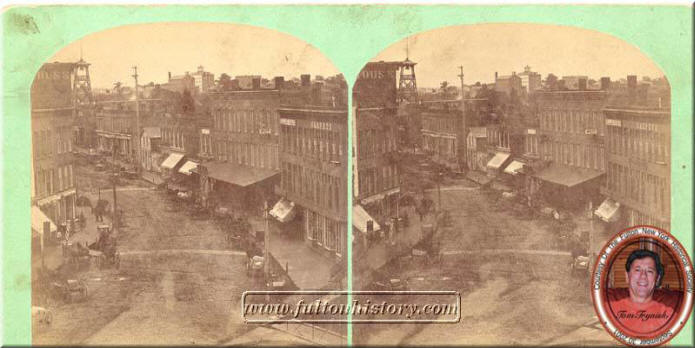Jerrems Family Newsletter
Dear Donald,
research: fultonhistory.com with over
6,120,000 Old New York State Historical Newspaper
Pages
Ray and Sandra have already drafted upstate New
York ancestorial remembrances from the mid-1800’s.
Watch for it.
There is a similarly named website: Fulton County
Historical Society, Inc. McConnellsburg,
Pennsylvania . http://www.fultonhistory.org/
| Location, Location, Location |
Ray Jerrems, Our Genealogist, Historian
Location – It is Everywhere
In recent times in Australia we have had inflicted upon
us the mantra “Location, location, location!”. The
perpetrators have been real estate agents trying to
convince us that we should buy a particular house
because it has a good location for resale.
Having lived in the same house for 36 years Di and I
find this rather irrelevant. But I have found the principle
of “location” relevant to my genealogical research.
Often I have found that by working out the location of
where people lived I have been able to work out their
relationship to each other.
The first time I used this idea was when I found that
the early Gainsborough Jerrems families
came from a “cluster” of villages gathered around
Gainsborough. I did not twig to this for a long while
because I did not realise that Gainsborough (in
Lincolnshire) is close to a county boundary,
and some of the nearby villages are in
Nottinghamshire.
Originally I had grouped all the 18th and 19th Century
Lincolnshire people together in one category and all
the Nottinghamshire people for the same period in
another category. After a while I realised that people
in the Lincolnshire group seemed to have married
people with the same name in the Nottinghamshire
group. So I googled a website that gives
driving directions and found that the towns and
villages were in fact quite close together. Darby
and
Joan had lived within easy travelling distance of
each
other. Eureka, it now all made sense!
Similarly Sandra and I recently made some
interesting
discoveries about James Jerrems, on her side of the
family. Initially I worked out that when James Snr
and
his son (the blacksmith) had both moved from the
State of New York all the way to different towns in
Illinois in the 1860s they had in fact moved to localities
no more than 10 kilometres apart. The family
had not disintegrated after all!
At the same time Sandra solved the puzzle of why,
some years later, James and his wife Caroline
kept
popping up in Nebraska and Kansas State
Censuses. Surely they had not been moving house
backwards and forwards at such a rapid rate,
particularly when they were in their sixties and
seventies? Then Sandra realised that the village they
lived in was in Kansas near the State boundary, and
that some of their adult children lived in a village in
Nebraska which was only a mile away. The likely
explanation was that they had not moved at all, they
had merely been visiting their children on the
Nebraska census days.
Finding out where people lived is not therefore just
idle curiosity, in some instances it is vital to test
whether the information you have located can be
logically correct.
| FultonHistory Website |
Ray Jerrems, Internet Sleuth
Tracing the Past with Modern Technology

In her research on her family history Sandra
has recently been making extensive use of a
particular website, fultonhistory.com. This
website has a mindboggling database of about
1,500,000 newspapers published in the north, north
west and central parts of New York State from
about 1840 up to
modern times. Obviously there are search
engines
like Google that access far more documents than this,
but as a single-purpose website available to the
public free (distinguishing it from ancestry.com, much
of which is not free) it must be almost unique.
Sandra was born in Utica in Central New York
State,
and her ancestors on both her mother’s and her
father’s side trace back over 150 years in that area, so
fultonhistory.com has proved to be a mine of
information for her.
Sandra first heard of the fulton website late last year
when Sarah Papageorge told her about it.
The strange thing is that in all my previous research
on the Jerrems family I had only had one hit on “fulton”
by using Google, and that was for a “Nicoll the Tailor”
trade card. This one instance did not give me any
inkling of the scope of the website. When I logged
directly on to “fulton” at Sandra’s suggestion I
obtained about 130 hits for Jerrems and 100 for Nicoll
the Tailor. Wow!
In the 19th Century newspapers were the main source
of information for the public. No radios, TV or internet
in those days, and a limited range of magazines. In
addition to what we would call “news” the
newspapers covered a wide range of other subjects
of local interest, including recipes, reports on
meetings, births, deaths and marriages, court reports,
arrivals and departures of citizens, summaries of
sermons, and items for purchase and sale. The latter
included the usual array of cure-alls and patent
medicines which purportedly cured everything from
snake bite and ingrown toenails to dropsy and
consumption. The style of journalism tended to be
melodramatic and the contents of the items were
sometimes gory.
The result is that the 19th century newspapers give
remarkable insights into the lives, attitudes and
interests of the people. These would be similar for all
people of that era, whether they lived in the US or
Australia.
From the 1880s the newspapers appear to have had
access to cable reports, similar to Reuters but on a
much smaller scale.
The result is that there is a lot of repetition of the same
items in newspapers in different cities and towns.
This was particularly noticeable for reports on gridiron
matches, which were reported by the New York Times.
One of the main teams was Yale University, and
Alexander Nicholl Jerrems was one of Yale’s
star
players in the mid 1890s. My excitement at getting so
many hits listed for “Jerrems” soon waned when I
realised that most of them were for Alexander, and
that they were merely repetitions of the New York
Times articles.
On the “plus” side, this access to a cable service
means that the newspapers carried a sprinkling of
reports of events occurring in other States.
The standard of reproduction of the newspapers is
variable. The resolution of some of the scanning
leaves a lot to be desired (possibly it was carried out
some time ago), making it somewhat of a guessing
game to interpret the documents in some instances.
The newspaper reproductions are in the form of PDF
files which can be copied and transferred to your
computer. The searching capability is extremely fast,
about the same as Google, a remarkable feat for a
non-profit organisation.
Another interesting aspect of the website is that it
plays old radio reports of famous events.
I will pick out some classic newpaper items in the
future and submit them to Donald for inclusion in the
Journal.
So, next time you are on the Internet log on to
fultonhistory.com and take an excursion back
in time
to the 19th Century!
| Administrivia |
Donald Jerrems, All-purpose Editor and More.
Newest Subscriber #48
We have a new subscriber, Ray and Jean
Lloyd, from the UK. They met Sandra
through the Ancestry.com connection service.
Here is what Ray Lloyd has to say about his
connection:
Please can I be subscribed to your Jerrems Journal.
I am a descendant of the Jerrams family. This
being the spelling we have but it is also spelled as
Jerromes in some places. My Great Grandfather was
Samuel Jerrams son of Thomas Jerrams and
Lucy Saunders.
| Parent and Grandparents News |
Second Granddaughter for Ray and Di; sister for Samantha

Ray
and his wife Diane:
Their daughter Anita had a baby girl on
Sunday April
13th, named Samantha. Her weight was 8 pounds 2
ounces (isn’t it interesting how the imperial weights
are still used in Australia for babies, over 40 years
after Australia went to metric measurements?).
Her husband Brad was so excited that when
he was
driving her to the hospital he ran into the back of
another car, fortunately with minimal damage (to the
other car, that is).
Congratulations to Brad and Anita.
On the following Saturday Samantha and her older
sister Jessica joined in celebrations when a
racehorse (Sebring) partly owned by Brad’s
family won
the Golden Slipper race in Sydney. This is one of the
top races in the world for 2 year olds.
Above is photo of Sebring and trainer.
Photos of
Samantha to follow.

